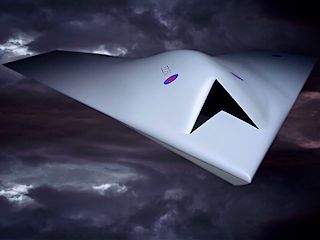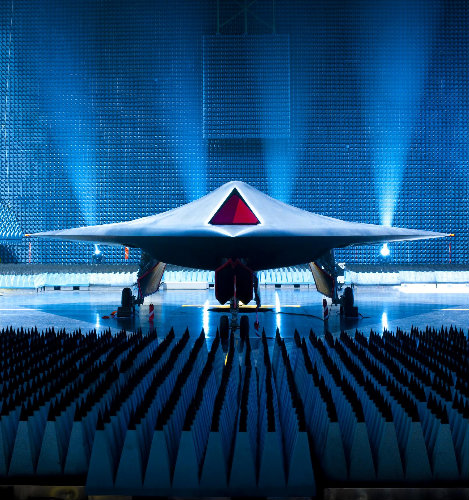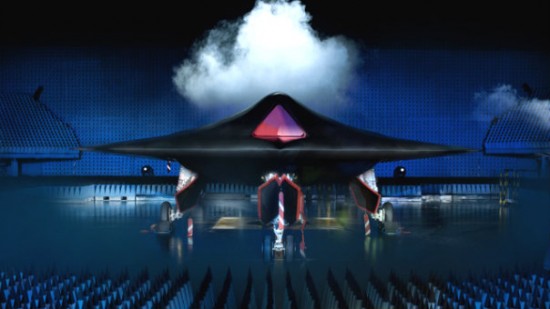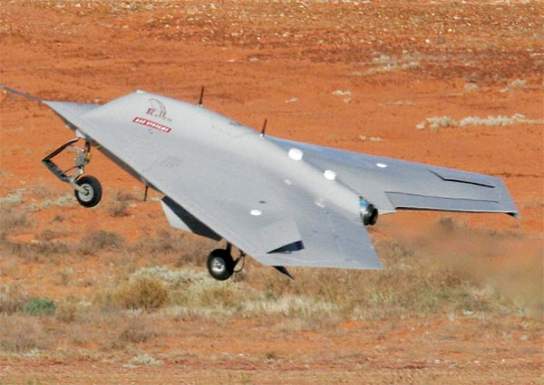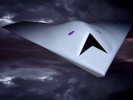 Yet another potent UAV is in the development phase, this one for the UK Ministry of Defence to be constructed by a team headed by BAE Systems, together with Rolls-Royce, Smiths Aerospace and QinetiQ, plus MoD military staff and scientists. The four year project to develop a world-class UAV (Unmanned Air Vehicle) Technology Demonstrator Programme called Taranis. Ground testing of the UKP124 million Taranis project is expected to take place in early 2009 with the first flight trials taking place in 2010. Named after the Celtic God of Thunder, Taranis will be an unmanned fast jet demonstrator the size of a Hawk trainer – making it one of the world’s largest UAVs – that will be stealthy, fast and be able to test deploy a range of munitions over a number of targets and be able to defend itself against manned and other unmanned enemy aircraft.
Yet another potent UAV is in the development phase, this one for the UK Ministry of Defence to be constructed by a team headed by BAE Systems, together with Rolls-Royce, Smiths Aerospace and QinetiQ, plus MoD military staff and scientists. The four year project to develop a world-class UAV (Unmanned Air Vehicle) Technology Demonstrator Programme called Taranis. Ground testing of the UKP124 million Taranis project is expected to take place in early 2009 with the first flight trials taking place in 2010. Named after the Celtic God of Thunder, Taranis will be an unmanned fast jet demonstrator the size of a Hawk trainer – making it one of the world’s largest UAVs – that will be stealthy, fast and be able to test deploy a range of munitions over a number of targets and be able to defend itself against manned and other unmanned enemy aircraft.
The four-year Taranis project, part of the UK Government’s Strategic Unmanned Air Vehicle (Experimental) Programme [SUAV(E)], will result in a UAV with fully integrated autonomous systems and low observable features.
About the size of a BAE Systems Hawk, Taranis will provide the MoD with experimental evidence on the potential capabilities of this class of UAV and help to inform decisions on the future mix of manned and unmanned fast jet aircraft.
Taranis is jointly funded by the UK MoD and UK industry, and will bring together a number of technologies, capabilities and systems to produce a technology demonstrator based around a fully autonomous intelligent system.
In addition to the existing industry partners, the project will also engage a significant number of other UK suppliers who will provide the programme with supporting technology and components.
Mike Turner, Chief Executive of BAE Systems, said: “This project supports many of the key drivers outlined in the Defence Industrial Strategy – in particular the way in which we, as a nation, continue to develop a sustainable sovereign capability by supporting UK design and engineering skills. This is an important project in light of the way in which military operations are changing.”
Mark Kane, managing director of Autonomous Systems & Future Capability (Air) for BAE Systems, said: “Taranis will make use of at least 10 years of research and development into low observables, systems integration, control infrastructure and full autonomy. It follows the completion of risk reduction activities to ensure the mix of technologies, materials and systems used are robust enough for the ‘next logical step’. These risk reduction activities include the Replica* programme, jointly funded with the MoD and the MoD funded ‘Nightjar’ programme.
He added: “Taranis will build on and use the technologies and systems trialled in the previous demonstrators we have produced such as Kestrel, Corax, Raven and HERTI. It is an important part of our future.”
BAE Systems, as prime contractor will provide many elements of the Taranis technology demonstrator, including the low observability, systems integration, control infrastructure and full autonomy elements (in partnership with QinetiQ); Rolls-Royce will focus on the next generation propulsion installation for the demonstrator and Smiths Aerospace will utilise their skills in ‘vehicle systems’. The TDP Programme will also use a number of other suppliers, some of which have already been selected, including the supply of flight control computing from BAE Systems Australia, one of the few non UK developments expected in the programme and support from BAE Systems Integrated System Technologies (INSYTE) with C4ISTAR related work.
“This contract will test cutting edge technology for a new generation of equipment for our front line forces. This is something that would not be out of place in the latest James Bond film – a pilotless combat aircraft for the British Armed Forces that will be capable of delivering weapons to a battlefield in another continent with almost no need for operator input,” Lord Drayson said.
“It does not come much more exciting than that. Taranis has the potential to revolutionise the way we conduct military operations. It is every bit as significant as vertical lift technology that we see in the Harrier or the advent of the attack helicopter.
“The partnership between the MOD and industry led by BAE is an example of what lies at the heart of the Defence Industrial Strategy that was launched a year ago – ensuring MOD and industry work together more effectively to ensure our Forces get the equipment they need.”
“The experience and knowledge gained from Taranis will also support the next generation of combat aircraft including the Joint Strike Fighter. It will empower decisions the RAF and MOD need to make at the start of the next decade on future air capability and the mix between manned and unmanned aircraft.
“If Barnes Wallis and RJ Mitchell were here today they would be impressed.”
[youtube]http://www.youtube.com/watch?v=kQYMBz1w08k[/youtube]
Assistant Chief of the Air Staff, Air Vice-Marshal Chris Moran added, “This is a very exciting programme – it will deliver important developments for the RAF of the future and add a new dimension to the force mix which should enhance our battle-winning capability. This is a cornerstone capability transformation for Defence.
“Taranis represents an historic milestone in the UK’s drive to develop a stealthy unmanned combat aerial vehicle to deliver capability in the deep battle of the future.”
The Replica programme
The Replica programme had the objective of supporting the development of a UK capability to provide a survivable, affordable and supportable air platform to meet perceived Royal Air Force and Royal Navy requirements beyond current programmes. Replica resulted in the production of a full scale Model of a radar signature controlled aircraft configuration, with key features representative of a flying integrated weapon system, which was then taken through a rigorous test programme. A key aim of the Replica programme was to demonstrate Low Observable (LO) technologies in a low cost design and production environment, using paperless aircraft processes.
The Nightjar programme
The Nightjar programme is an example of the technology programmes which are being exploited in this programme. The programme has played a crucial part in increasing the UK’s knowledge and understanding of how to design and manufacture future air vehicles. The aim of the Nightjar programme was to explore the integration of new airframe features, which could be critical for the future of air vehicle design. The programme provided stepped increases in valuable data on issues surrounding design, aerodynamics, manufacturing and in-service performance limits.
The Raven programme
The Raven programme has already successfully demonstrated some of the key technologies required for the programme. It was run in the BAE Systems Advanced Technology Demonstration Centre at Warton during 2003/4 and in ten months was taken from concept to first flight. The system was targeted at demonstrating flight control and autonomous system functionality along with ‘rapid prototyping’ techniques and capabilities.
[youtube]http://www.youtube.com/watch?v=eITS4R11kGY[/youtube]


